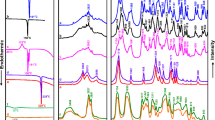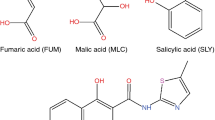Abstract
A tool for quick screening co-crystal formation between indomethacin (IMC) and saccharin (SAC) was attempted using DSC analytical technique or DSC–FTIR microspectroscopy as an accelerated method. The solid-state characterizations of IMC, SAC, and their physical, 30-min ground, or solvent-evaporated mixture, were, respectively, investigated. The DSC data evidences that two endothermic peaks at 154 and 184 °C but one exothermic peak at 158 °C were observed in the DSC curve of the physical mixture of IMC–SAC. The former appeared at 154 °C might be due to the fusion of eutectic mixture, but the latter at 184 °C was corresponded to the melting point of IMC–SAC co-crystal following the exothermic peak at 158 °C. The exothermic peak at 158 °C was due to the induction of molecular interaction of IMC and SAC, leading to IMC–SAC co-crystal formation. This indicates that DSC analytical technique could directly detect the thermal changes of the physical mixture of IMC–SAC to form an IMC–SAC co-crystal. Once the temperature was beyond 154 °C after determination with DSC–FTIR microspectroscopy, several new IR absorption peaks at 3165, 1736, 1684, 1319, 1221, and 1176 cm−1 due to the IMC–SAC co-crystal formation via an intermolecular interaction were simultaneously observed from the thermal-dependent three-dimensional FTIR spectral contour. This one-step DSC–FTIR microspectroscopic system giving thermodynamic and spectroscopic information could easily and directly screen and detect the IMC–SAC co-crystal formation in real time.









Similar content being viewed by others
References
Sun CC. Cocrystallization for successful drug delivery. Expert Opin Drug Deliv. 2013;10:201–13.
Chadha R, Saini A, Arora P, Bhandari S. Pharmaceutical cocrystals: a novel approach for oral bioavailability enhancement of drugs. Crit Rev Ther Drug Carr Syst. 2012;29:183–218.
Blagden N, de Matas M, Gavan PT, York P. Crystal engineering of active pharmaceutical ingredients to improve solubility and dissolution rates. Adv Drug Deliv Rev. 2007;59:617–30.
Qiao N, Li M, Schlindwein W, Malek N, Davies A, Trappitt G. Pharmaceutical cocrystals: an overview. Int J Pharm. 2011;419:1–11.
Friščić T, Jones W. Benefits of cocrystallisation in pharmaceutical materials science: an update. J Pharm Pharmacol. 2010;62:1547–59.
Steed JW. The role of co-crystals in pharmaceutical design. Trends Pharmacol Sci. 2013;34:185–93.
Mirza S, Miroshnyk I, Heinämäki J, Yliruusi J. Co-crystals: an emerging approach for enhancing properties of pharmaceutical solids. Dosis. 2008;24:90–6.
Yadav AV, Shete AS, Dabke AP, Kulkarni PV, Sakhare SS. Co-crystals: a novel approach to modify physicochemical properties of active pharmaceutical ingredients. Indian J Pharm Sci. 2009;71:359–70.
Thakuria R, Delori A, Jones W, Lipert MP, Roy L, Rodríguez-Hornedo N. Pharmaceutical cocrystals and poorly soluble drugs. Int J Pharm. 2013;453:101–25.
FDA. Guidance for industry: regulatory classification of pharmaceutical co-crystals. April, 2013.
Miroshnyk I, Mirza S, Sandler N. Pharmaceutical co-crystals-an opportunity for drug product enhancement. Expert Opin Drug Deliv. 2009;6:333–41.
Trask AV. An overview of pharmaceutical cocrystals as intellectual property. Mol Pharm. 2007;4:301–9.
Sekhon BS. Pharmaceutical co-crystals: a review. Ars Pharm. 2009;50:99–117.
Bysouth SR, Bis JA, Igo D. Cocrystallization via planetary milling: enhancing throughput of solid-state screening methods. Int J Pharm. 2011;411:169–71.
Shan N, Toda F, Jones W. Mechanochemistry and co-crystal formation: effect of solvent on reaction kinetics. Chem Commun. 2002;21:2372–3.
Trask AV, Motherwell WDS, Jones W. Mechanochemistry and co-crystal formation: effect of solvent on reaction kinetics. Chem Commun. 2004;23:890–1.
Braga D, Maini L, Grepioni F. Mechanochemical preparation of co-crystals. Chem Soc Rev. 2013;42:7638–48.
Zhang GC, Lin HL, Lin SY. Thermal analysis and FTIR spectral curve-fitting investigation of formation mechanism and stability of indomethacin–saccharin cocrystals via solid-state grinding process. J Pharm Biomed Anal. 2012;66:162–9.
Hsu PC, Lin HL, Wang SL, Lin SY. Solid-state thermal behavior and stability studies of theophylline-citric acid cocrystals prepared by neat cogrinding or thermal treatment. J Solid State Chem. 2012;192:238–45.
Berry DJ, Seaton CC, Clegg W, Harrington RW, Coles SJ, Norton PN, Hursthouse MB, Storey R, Jones W, Blagden N. Applying hot-stage microscopy of co-crystal screening: a study of nicotinamide with seven active pharmaceutical ingredients. Cryst Growth Des. 2008;8:1697–712.
Lu E, Rodríguez-Hornedo N, Suryanarayanan R. A rapid thermal method for cocrystal screening. CrystEngComm. 2008;10:665–8.
Wu TK, Lin SY, Lin HL, Huang YT. Simultaneous DSC–FTIR microspectroscopy used to screen and detect the co-crystal formation in real time. Bioorg Med Chem Lett. 2011;21:3148–51.
Hsu CH, Lin SY. Rapid examination of the kinetic process of intramolecular lactamization of gabapentin using DSC–FTIR. Thermochim Acta. 2009;486:5–10.
Lin SY, Cheng WT, Wei YS, Lin HL. DSC–FTIR microspectroscopy used to investigate the thermal-induced Intramolecular cyclic anhydride formation between Eudragit E and PVA copolymer. Polym J. 2011;43:577–80.
Wang SL, Wong YC, Cheng WT, Lin SY. A continuous process for solid-state dehydration, amorphization and recrystallization of metoclopramide HCL monohydrate studied by simultaneous DSC–FTIR microspectroscopy. J Thermal Anal Calorim. 2011;104:261–4.
Lin SY, Wang SL. Advances in simultaneous DSC–FTIR microspectroscopy for rapid solid-state chemical stability studies: some dipeptide drugs as examples. Adv Drug Deliv Rev. 2012;64:461–78.
Basavoju S, Boström D, Velaga SP. Indomethacin–saccharin cocrystal: design, synthesis and preliminary pharmaceutical characterization. Pharm Res. 2008;25:530–41.
Allesø M, Velaga SP, Alhalaweh A, Cornett C, Rasmussen MA, Van den Berg F, de Diego HL, Rantanen J. Near-infrared spectroscopy for cocrystal screening. A comparative study with Raman spectroscopy. Anal Chem. 2008;80:7755–64.
Mohammad MA, Alhalaweh A, Velaga SP. Hansen solubility parameter as a tool to predict cocrystal formation. Int J Pharm. 2011;407:63–71.
Pal S, Roopa BN, Abu K, Manjunath SG, Nambiar S. Thermal studies of furosemide–caffeine binary system that forms a cocrystal. J Therm Anal Calorim. 2014;115:2261–8.
Padrela L, Rodrigues MA, Velaga SP, Matos HA, de Azevedo EG. Formation of indomethacin–saccharin cocrystals using supercritical fluid technology. Eur J Pharm Sci. 2009;38:9–17.
Mura P, Cirri M, Faucci MT, Ginès-Dorado JM, Bettinetti GP. Investigation of the effects of grinding and co-grinding on physicochemical properties of glisentide. J Pharm Biomed Anal. 2002;30:227–37.
Giron D. Thermal analysis, microcalorimetry and combined techniques for the study of pharmaceuticals. J Therm Anal Calorim. 1999;56:1285–304.
Drebushchak VA, Drebushchak TN, Boldyreva EV. New interpretation of heat effects in polymorphic transitions. J Therm Anal Calorim. 2013;113:419–24.
Umeda Y, Fukami T, Furuishi T, Suzuki T, Makimura M, Tomono K. Molecular complex consisting of two typical external medicines: intermolecular interaction between indomethacin and lidocaine. Chem Pharm Bull (Tokyo). 2007;55:832–6.
Wang F, Hui H, Barnes TJ, Barnett C, Prestidge CA. Oxidized mesoporous silicon microparticles for improved oral delivery of poorly soluble drugs. Mol Pharm. 2010;7:227–36.
Del Arco M, Cebadera E, Gutiérrez S, Martín C, Montero MJ, Rives V, Rocha J, Sevilla MA. Mg, Al layered double hydroxides with intercalated indomethacin: synthesis, characterization, and pharmacological study. J Pharm Sci. 2004;93:1649–58.
Jayasankar A, Somwangthanaroj A, Shao ZJ, Rodríguez-Hornedo N. Cocrystal formation during cogrinding and storage is mediated by amorphous phase. Pharm Res. 2006;23:2381–92.
Jovanovski G. The SO2 stretching vibrations in some metal saccharinates: spectra-structure correlations. Spectrosc Lett. 1995;28:1095–109.
Ali HRH, Alhalaweh A, Mendes NFC, Ribeiro-Claro P, Velaga SP. Solid-state vibrational spectroscopic investigation of cocrystals and salt of indomethacin. CrystEngComm. 2012;14:6665–74.
Tong P, Zografi G. A study of amorphous molecular dispersions of indomethacin and its sodium salt. J Pharm Sci. 2001;90:1991–2004.
Terife G, Wang P, Faridi N, Gogos CG. Hot melt mixing and foaming of soluplus and indomethacin. Polym Eng Sci. 2012;52:1629–39.
Acknowledgements
This work was supported by National Science Council, Taipei, Taiwan, ROC (NSC 100-2320-B-264-001-MY3).
Conflict of interest
None.
Author information
Authors and Affiliations
Corresponding authors
Rights and permissions
About this article
Cite this article
Lin, HL., Zhang, GC. & Lin, SY. Real-time co-crystal screening and formation between indomethacin and saccharin via DSC analytical technique or DSC–FTIR microspectroscopy. J Therm Anal Calorim 120, 679–687 (2015). https://doi.org/10.1007/s10973-014-3787-2
Received:
Accepted:
Published:
Issue Date:
DOI: https://doi.org/10.1007/s10973-014-3787-2




